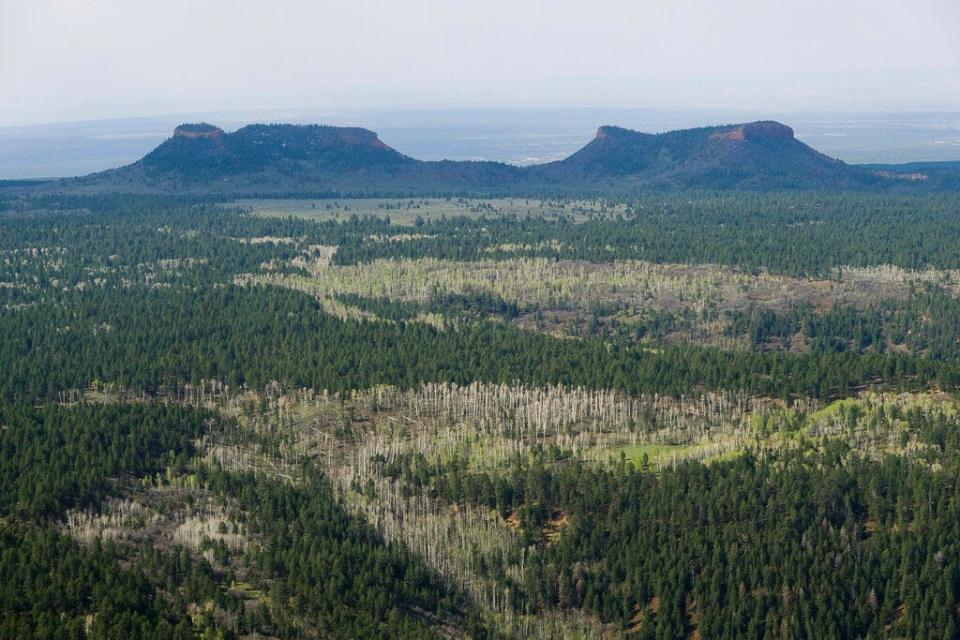Federal judge dismisses Utah's lawsuit over national monuments
- Oops!Something went wrong.Please try again later.
- Oops!Something went wrong.Please try again later.
Just days after President Joe Biden declared a new national monument near the Grand Canyon south of the Utah border, a federal judge has tossed the state's lawsuit against Biden over his restoration of the Bears Ears and Grand Staircase national monuments.
In a decision filed on Friday, U.S. District Court Judge David Nuffer ruled that the Antiquities Act grants the president broad authority to designate national monuments, rejecting a claim from politicians in Utah that the president's declaration was too broad.
"In spite of the sincere and deeply held view of the Plaintiffs, there is no relief for them in this action," Nuffer wrote.
Utah Attorney General Sean Reyes announced plans to appeal the order.
"The Attorney General’s Office respectfully but strongly disagrees with the court’s order on the Monuments case today," Reyes said in a written statement. "We will appeal the dismissal in order to stand up against President Biden’s egregious abuse of the Antiquities Act."
More: Republicans in Utah, elsewhere, blast Biden over Grand Canyon monument designation
The coalition of Native American tribes and conservation groups that asked for the dismissal were celebrating on Friday, arguing the ruling served as a reminder that no court has been willing to review, let alone reverse, the designation of a national monument.
"Bears Ears and Grand Staircase-Escalante National Monuments are prized by the American people and many tribes for whom the lands are sacred," said Scott Miller, the regional director of The Wilderness Society. "The court’s order dismissing Utah’s lawsuit is a win for these spectacular public lands, for the preservation of tribal cultures and resources, for the economies of local communities and for the rule of law."
The ruling marks the latest in an ongoing dispute over the two monuments and monument designations in general along the sparsely populated, geologically unique and mostly publicly-owned lands along the Utah-Arizona border.
Most of the arguments have centered around the Antiquities Act, a century-old law signed by Theodore Roosevelt to protect public lands.
The law gives the president broad power to establish national monuments as a way to protect federal land that contains “historic landmarks, historic and prehistoric structures, and other objects of historic or scientific interest.”

Many U.S. national parks started as national monuments, including four of the “Mighty Five” national parks in Utah, and there more than 130 monuments across the country.
Then-president Bill Clinton designated the Grand Staircase-Escalante National Monument in 1996 and Barack Obama created the Bears Ears monument in the waning days of his administration. Donald Trump then ordered both to be shrunk significantly, only to have them restored to roughly their original boundaries under Biden.
The back-and-forth political battle was again part of the conversation earlier this week, when Biden created the new Baaj Nwaavjo I’tah Kukveni monument south of the Utah border on lands surrounding the Grand Canyon National Park.
More: Biden dedicates new monument for Arizona tribes and 'the soul of the nation'
Most of the land under designation was already federally-owned, but open to various other uses like mining, logging, grazing and road building, that are now limited under monument designation.
Biden said the new designation would see the federal government live up to its treaty obligations with Native American tribes, some of which were forced out of their ancestral homes around the Grand Canyon when the national park was created. U.S. Interior Secretary Deb Haaland said the monument would give tribal members a voice in managing lands where they and their ancestors have long lived, farmed and prayed.
"It’s been a banner week for national monuments on the Colorado Plateau," said Tim Peterson, cultural landscapes director with the Grand Canyon Trust. "As we celebrate the creation of Baaj Nwaavjo I’tah Kukveni − Ancestral Footprints of Grand Canyon National Monument, we rejoice at the news that the state of Utah’s lawsuit attempting to destroy Bears Ears and Grand Staircase-Escalante National Monuments has been dismissed."
This article originally appeared on St. George Spectrum & Daily News: Judge dismisses Utah's lawsuit over national monuments

